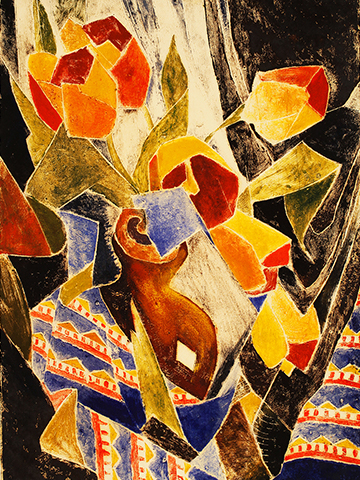Originally published October 16, 2017 at 6:00 am by Michael Upchurch, Special to the Seattle Times
Over the last 25 years, Seattle curator David F. Martin has been on a search-and-rescue mission, uncovering lost chapters in the history of Pacific Northwest Art.
He has placed shows by such remarkable figures as photographer Virna Haffer and painter Z. Vanessa Helder at the Tacoma Art Museum. At Seattle’s Henry Art Gallery, he found a home for an exhibit about the Seattle Camera Club, which flourished in the 1930s. And two years ago, he found a home at Edmonds’ Cascadia Art Museum (CAM), where he has staged show after show investigating what went on in our local 20th-century art scene besides the well-known work of Mark Tobey, Morris Graves and company.
“Territorial Hues: The Color Print and Washington State, 1920-1960” is his most ambitious effort yet. It’s also a first for CAM in that it comes with a handsome catalog written by Martin.
Works by individual artists are grouped so you can savor their achievement at a glance. An entire room is devoted to the work of brothers W. Corwin Chase and Waldo S. Chase, and it’s full of surprises.
Waldo Chase’s color woodblock prints play with color in especially unexpected ways. “Seattle Skyline” (1927) catches the city in silhouette at dawn with Mount Rainier looming over it, half sharp and half ethereal in outline, with strange bands of cloud-pink and cloud-orange accenting the sky around it. “Whither” resembles a scene from a dreamy Western as four riders and a packhorse climb a hill with a towering thunderhead as their goal. Two versions of a print called “Goat Hunters” contrast foreground shadows (almost concealing the hunters of the title) with a bright, sunlit peak rising above them.
The most startling work is Waldo Chase’s 1928 portrait of novelist Bertrand Collins, depicting the author of “Rome Express” (about well-to-do Seattleites in Europe) all in pink against a turquoise background. It’s an Andy Warhol portrait 40 years ahead of its time.
Corwin Chase’s surprises are subtler. In some of his landscapes (“Mount Baker,” “Elephant Butte”), his towering peaks and rising promontories seem to float and half-dissolve in the atmosphere around them. A souvenir from his travels, “Storm over Oahu, Hawaii” (1934), makes a still more intricate continuum of ocean, mountain peaks and threatening sky.
Martin’s catalog makes clear what an eccentric pair the Chase brothers were, posing nude for photographer Haffer (in Corwin’s case), living in tepees near Mount Rainier and on Queen Anne Hill, and traveling by bicycle to create 320 woodblock prints for the Hotel Georgia in Vancouver, B.C. (They were sent packing two weeks before the hotel opened after falling out with the developer.)
The Chases have the liveliest tales behind them, but other artists in the show make an equally big impression. Elizabeth Warhanik’s white-line color woodblock prints (floral studies, still lifes, abstractions) have a tawny, stained-glass richness to them. “On Puget Sound,” a shoreline landscape, is gorgeous, too.
Glen Alps’ abstract serigraphs, collagraphs and color lithographs have a fugue-like splendor to them, and Danny Pierce’s mixed intaglio prints do something similar, fusing organic and geometric shapes in ever-inventive ways. Helmi Juvonen’s linocuts blend Native American-influenced imagery with the busy “white writing” technique of her idol, Mark Tobey. The color woodblock prints of James Washington, Jr., capture images of jazz musicians and gospel choirs in enchanting ways.
There’s real variety here, and not every artist will be to every viewer’s taste. But all in all, “Territorial Hues” offers a fascinating excursion into our artistic past.
Find the original article here: www.seattletimes.com


